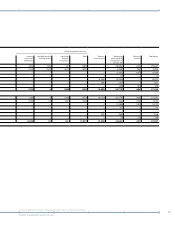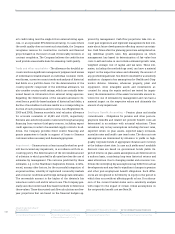Siemens 2009 Annual Report Download - page 221
Download and view the complete annual report
Please find page 221 of the 2009 Siemens annual report below. You can navigate through the pages in the report by either clicking on the pages listed below, or by using the keyword search tool below to find specific information within the annual report.
Managing Board statements, Independent auditors’ report, Additional information
Notes to Consolidated Financial Statements
(in millions of €, except where otherwise
stated and per share amounts)
be recoverable. Recoverability of assets is measured by the
comparison of the carrying amount of the asset to the recover-
able amount, which is the higher of the asset’s value in use
and its fair value less costs to sell. If adequate, the impairment
test is not performed at an individual asset level, instead, it is
performed at the level of the cash-generating unit the asset
belongs to. If such assets are considered to be impaired, the
impairment to be recognized is measured by the amount by
which the carrying amount of the assets or cash generating
unit exceeds their recoverable amount. If the fair value cannot
be determined, the assets’ value in use is applied as their re-
coverable amount. The assets’ value in use is measured by dis-
counting their estimated future cash flows. If there is an indi-
cation that the reasons which caused the impairment no lon-
ger exist, Siemens would assess the need to reverse all or a
portion of the impairment.
The Company ’s property, plant and equipment and other in-
tangible assets to be disposed of are recorded at the lower of
carrying amount or fair value less costs to sell and deprecia-
tion is ceased.
Discontinued operations – Discontinued operations are re-
ported when a component of an entity comprising operations
and cash flows that can be clearly distinguished, operationally
and for financial reporting purposes, from the rest of the entity
is classified as held for sale or has been disposed of, if the com-
ponent either (a) represents a separate major line of business
or geographical area of operations or (b) is part of a single co-
ordinated plan to dispose of a separate major line of business
or geographical area of operations or (c) is a subsidiary ac-
quired exclusively with a view to resale.
Income taxes – The Company applies IAS 12, Income Taxes.
Under the liability method of IAS 12, deferred tax assets and li-
abilities are recognized for the future tax consequences attrib-
utable to differences between the financial statement carrying
amounts of existing assets and liabilities and their respective
tax bases. The effect on deferred tax assets and liabilities of a
change in tax rates is recognized in the income statement, un-
less related to items directly recognized in equity, in the period
the new laws are substantively enacted. Deferred tax assets
are recognized to the extent that it is probable that future tax-
Other intangible assets – Other intangible assets consist of
software and other internally generated intangible assets, pat-
ents, licenses and similar rights. The Company amortizes in-
tangible assets with finite useful lives on a straight-line basis
over their respective estimated useful lives to their estimated
residual values. Estimated useful lives for software, patents, li-
censes and other similar rights generally range from three to
five years, except for intangible assets with finite useful lives
acquired in business combinations. Intangible assets acquired
in business combinations primarily consist of customer rela-
tionships and technology. Weighted average useful lives in
specific acquisitions ranged from nine to twenty-two years for
customer relationships and from seven to twelve years for
technology. Intangible assets which are determined to have
indefinite useful lives as well as intangible assets not yet avail-
able for use are not amortized, but instead tested for impair-
ment at least annually.
Property, plant and equipment – Property, plant and equip-
ment is valued at cost less accumulated depreciation and im-
pairment losses. If the costs of certain components of an item
of property, plant and equipment are significant in relation to
the total cost of the item, they are accounted for and depreci-
ated separately. Depreciation expense is recognized using the
straight-line method. Costs of construction of qualifying as-
sets, i.e. assets that require a substantial period of time to be
ready for its intended use, include capitalized interest, which
is amortized over the estimated useful life of the related asset.
The following useful lives are assumed:
Impairment of property, plant and equipment and other in-
tangible assets with finite useful lives – The Company re-
views property, plant and equipment and other intangible as-
sets for impairment whenever events or changes in circum-
stances indicate that the carrying amount of an asset may not
Factory and office buildings 20 to 50 years
Other buildings 5 to 10 years
Technical machinery & equipment 5 to 10 years
Furniture & office equipment generally 5 years
Equipment leased to others generally 3 to 5 years
B27T002_E
























